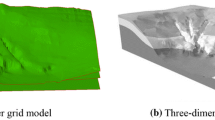Abstract
In this paper, based on a new Geographic Information System (GIS) grid-based three-dimensional (3D) deterministic model and taken the slope unit as the study object, the landslide hazard is mapped by the index of the 3D safety factor. Compared with the one-dimensional (1D) model of infinite slope, which is now widely used for deterministic model based landslide hazard assessment in GIS, the GIS grid-based 3D model is more acceptable and is more adaptable for three-dimensional landslide. Assuming the initial slip as the lower part of an ellipsoid, the 3D critical slip surface in the 3D slope stability analysis is obtained by means of a minimization of the 3D safety factor using the Monte Carlo random simulation. Using a hydraulic model tool for the watershed analysis in GIS, an automatic process has been developed for identifying the slope unit from digital elevation model (DEM) data. Compared with the grid-based landslide hazard mapping method, the slope unit possesses clear topographical meaning, so its results are more credible. All the calculations are implemented by a computational program, 3DSlopeGIS, in which a GIS component is used for fulfilling the GIS spatial analysis function, and all the data for the 3D slope safety factor calculation are in the form of GIS data (the vector and the grid layers). Because of all these merits of the GIS-based 3D landslide hazard mapping method, the complex algorithms and iteration procedures of the 3D problem can also be perfectly implemented.
Similar content being viewed by others
References
ALEOTTI P, CHOWDHURY R, 1999. Landslide hazard assessment: summary review and new perspectives[J]. Bull. Eng. Env., 58: 21–44.
ANBALAGAN D, 1992. Landslide hazard evaluation and zonation mapping in mountainous terrain [J]. Engineering Geology, 32; 269–277.
BALIGH M M, AZZOUZ A S, 1975. End effects on the stability of cohesive slopes [J]. ASCE journal of the Geotechnical Engineering Division, 101 (GT11): 1105–1117.
CARRARA A, 1995. GIS technology in mapping landside hazard[A]. In: CARRARA A, GUZZETTI F (eds.). Geographical Information Systems in Assessing Natural Hazards[C]. Dordrecht: Kluwer Acad. Publ., 135–176.
DAI F C, LEE C F, 2001. Terrain-based mapping of landslide susceptibility using a geographical information system: a case study[J]. Can. Geotech. J., 38: 911–923.
ESAKI T, XIE Mo-wen, ZHOU Guo-yun, 2001. 3D critical slope stability analysis based on GIS and Monte Carlo simulation[A]. In: DEREK E, JOHN P T, KEITH A H(eds.). The 38th U. S. Rock Mechanics Symposium “Rock Mechanics in the National Interest” [C]. Washington D. C.: A. A. Balkema Publishers, 1137–1143.
ESRI(Environmental System Research Institute), 1999. Map Objects Programmer’s Reference: GIS and Mapping Components[R]. Redlands: ESRI Press.
GRECO V R, 1996. Efficient Monte Carlo technique for locating critical slip surface[J]. Journal of Geotechnical Engineering, July: 517–525.
HOVLAND H J, 1977. Three-dimensional slope stability analysis method[J]. Journal of the Geotechnical Engineering, Division Proceedings of the American Society of Civil Engineers, 103 (GT9): 971–986.
NEWMARK N M, 1965. Effects of earthquakes on dams and embankents [J]. Geotechnique, 15: 139–160.
VAN WESTEN C J, TERLIEN M T J, 1996. Deterministic landslide hazard analysis in GIS: A case study from Manizales (Colombia) [J]. Earth Surface Processes and Landforms, 21: 853–868.
VAN WESTEN C J, RENGERS N, TERLIEN M T J, 1997. Prediction of the occurrence of slope instability phenomena through GIS-based hazard zonation[J]. Geologische Rundschau, 86: 404–414.
XIE MO-wen, ZHOU G, ESAKI T, 2001. Landslide hazard assessment using Monte Carlo simulation based on GIS [A]. In: CHANDRA S D et al. (eds.). The 10th International Conference of IACMAG [C]. Arizona: A. A. Balkema Publishers, 169–173.
Author information
Authors and Affiliations
Additional information
Foundation item: Under the auspices of Research Institute of Software Engineering (RISE) of Japan (No. 01-004).
Biography: XIE Mo-wen(1965 —), male, a native of Hubei Province of China, associate Prof. of Wuhan University, Ph. D. candidate of Kyushu University of Japan, specialized in geoenvironmental engineering, geotechnical engineering, GIS and GPS application.
Rights and permissions
About this article
Cite this article
Xie, Mw., Zhou, Gy. & Esaki, T. GIS component based 3D landslide hazard assessment system: 3DSlopeGIS. Chin. Geograph.Sc. 13, 66–72 (2003). https://doi.org/10.1007/s11769-003-0087-3
Received:
Issue Date:
DOI: https://doi.org/10.1007/s11769-003-0087-3
Key words
- Geographic Information System (GIS)
- three-dimensional slope stability
- Monte Carlo simulation
- slope unit
- landslide hazard




